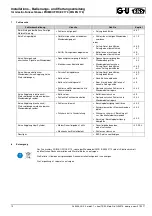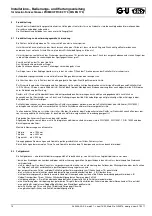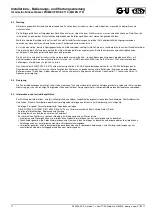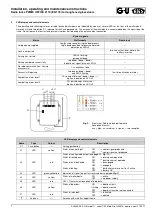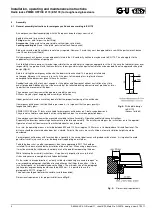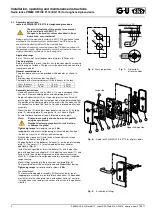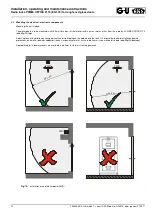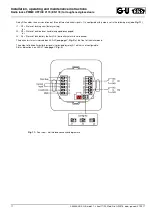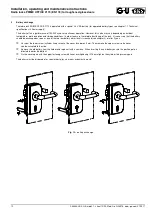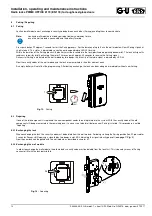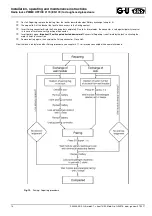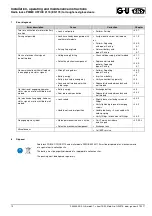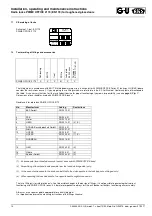
Installation, operating and maintenance instructions
Radio locks PRIME OFFICE 2170 (EN 179) for toughened glass doors
9
0-45648-3E-0-GB, modif. 1, sheet 9/20, Mod. No. G24578, www.g-u.com 01/2011
4.2
Assembly instructions
radio lock PRIME OFFICE 2170 for toughened glass doors
The security features of this product are essential
for its conformity with EN 179.
Changes to the product, unless described in these
instructions, are not allowed!
Being a part of the mandatory marking to EN 179, the adhesive labels
attached to this product must not be removed. The CE label on the
cover must be clearly visible with the lock installed.
In the case of locks with uncoated covers, the CE label is enclosed in
the package loosely. Before assembly, it must be attached to the cover
visibly and reliably, preferably on the locking side.
Application range
8 mm, 10 mm and 12 mm toughened safety glass (ESG quality).
Cleaning of glass
Before assembling the lock, the glass has to be cleaned with a cleaning
agent leaving no residues. The glass must be absolutely clean and free
from grease and oil.
General assembly advice
The glass door panel must be provided with boreholes as shown in
Fig. 6
.
For dimensions of lever handles see
Fig. 7
.
The length of the lever spindle must fit the thickness of the lock.
Glass thickness
8 mm
10 mm
12 mm
Lock thickness
38 mm
40 mm
42 mm
Assembly instructions
- Remove 2 countersunk screws M6x30 (1) using a hexagonal Allen
key size 4. Remove holding plates and clamping plates (2, 3).
- Apply self-adhesive film (5) on hinge side glass surface flush with
glass edge. The appropriate vertical position may be determined from
the position of the clamping plate on the other side. The adhesive film
will conceal the inside of the lock. Cut foil where protruding after lock
assembly.
- Mount the lock (4) to the glass door panel using screws (1), holding
plate (2), clamping plate (3), and gasket (6) as shown in
Fig. 8
.
Ensure that bevelled face of latch is directed towards glass.
Note: Ensure to accurately attach all protective gaskets
and glass protectors.
Negligent fastening may affect the lock function
or damage the glass!
Tightening torque
for clamping screws:
5 Nm
Inappropriate and excessive tightening or inaccurate positioning of
the lock may result in insufficient lock functioning.
- Attach hinge side cover (7) and fasten with countersunk screws
M4x6 (8) on front of lock (
Fig. 8
).
Engage the bore at the bottom of flat cover (9) on the pin of clamping
plate (3); The covers (7, 9) are clamped by the lever handles
additionally (
Fig. 9
).
- Install the locking cylinder. Insert the battery (10) with the positive
pole at the bottom (see chapter 5). Fit the battery case cover (11) and
fasten it with the cylinder fixing screw and the countersunk screw
M4x6 (8). Cylinder must be aligned accurately, otherwise it might be
rough-running.
- Mount fittings according to the instructions enclosed (
Fig. 9
).
The lever spindle must be axially aligned and fitted without tension.
Tightening torque
for rosette handle screws:
5 Nm
- Functional check:
The lock must be operable smoothly. Stiffness may be a sign of
inappropriate assembly or a distorted lock mechanism. The deadbolt
must enter into the strike plate freely and without friction at any time.
It may be necessary to adjust the cut-out of the strike to the particular
situation
Fig. 6:
Glass preparation
Fig. 7:
Dimensions
of lever handles
Hinge side
Opposite hinge side
Fig. 8:
Radio lock PRIME OFFICE 2170 for all-glass doors
Fig. 9:
Assembly of fittings

